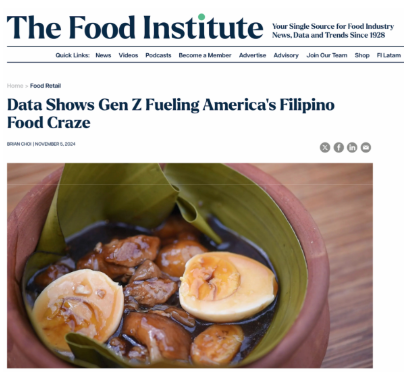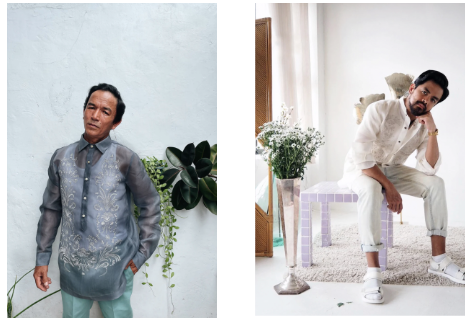Nikki’s Note Pearls of Wisdom
FILIPINO FOOD
An Ode to Gen Z: How Do I Love Thee?
Let Me Count the Wayz!
Dear Readers,
Filipino food is on fire! Fueled by grassroots entrepreneurship and an insatiable appetite for bold flavors, the rise of Filipino cuisine in America shows no signs of slowing down. It’s no surprise — foodie culture is the most accessible and inclusive social currency for all, fueled by new and delicious flavors, and Filipino food’s value is skyrocketing. Huge applause to the entrepreneurs and small business owners taking the leap and fueling this demand (my team included 😌). Truly, TGIF: Thank God I’m Filipino.
Eat Well,
Nikki
Dive into this article to see how Gen Z is leading the charge.
FILIPINO CULTURE
The Pearl of the Orient Seas: What Does It Mean?
By Danica Hooper, Guest Writer for VINTA Gallery
In its most basic history, the term “Pearl of the Orient Seas” comes from the natural beauty of the Philippines and its abundant source of pearls, which were valued for their beauty and rarity. This moniker was first used in 1751 by Spanish colonisers realising just how significant the Philippines’ location is for trade and commerce, being in between the Pacific Ocean and the West Philippine Sea. The Philippines had been trading with surrounding countries for thousands of years, trading gold, jade, ceramics, spices, silk, and more, with countries such as Indonesia, Thailand, Vietnam, Borneo, and China, before Spanish conquistadors even landed on our soil.
At the term’s genesis, the Sulu Sea was discovered to have the largest pearl beds in the world and would become the most important source of pearls for the next three centuries. The term “Pearl of the Orient Seas” was then popularised by Jose Rizal in his very last poem “Mi Ultimo Adios” (My Final Farewell), written the night before he was executed on December 30, 1896 for his rebellion against Spanish colonisers and the Spanish government in the Philippines. And in case you didn’t know, VINTA Gallery’s Creative Director, Caroline Mangosing, is a descendant of Jose Rizal! But let’s get deeper into this, shall we?
FILIPINO FASHION
VINTA Gallery, a Canadian brand that is reviving the craft and beauty of traditional Filipiniana fashion but with contemporary relevance.
Filipiniana refers to materials, artifacts, or items that represent Filipino culture, history, and heritage. It includes traditional attire like the Barong Tagalog and the Baro’t Saya or Terno, known for intricate embroidery and unique fabrics such as piña or jusi.
Paying tribute to the cosmopolitan chic glamour of Filipiniana fashion from the 1890s all the way to the 1960s, VINTA Gallery is an homage to heritage with a fresh perspective.
CLASSIC PECHERA BARONG (NEO CLASSIC)
VINTA Gallery $275.00
The Barong Tagalog, or Barong, is a form of traditional formal attire in the Philippines, often worn during weddings, state events, and other important occasions. Made from lightweight and sheer fabrics like piña (pineapple fiber), jusi (silk), or synthetic blends, it features intricate hand embroidery, typically along the chest and cuffs. Its design includes long sleeves, a standing or collarless neckline, and it is worn untucked over an undershirt for a polished yet comfortable look. While traditionally off-white or cream, modern variations now include darker and more colorful options.
A symbol of Filipino identity and pride, the Barong combines indigenous design with Spanish colonial influences, reflecting the elegance and formality of Filipino culture. Its lightweight material is practical for the tropical climate, making it both functional and sophisticated. As a national attire, it continues to evolve with modern adaptations while maintaining its cultural heritage.
TERNO HARNESS (JUSI), VINTA Gallery (L)
DEEP-V MAXI TERNO DRESS, VINTA Gallery ®
The Terno is a traditional Filipino formal attire known for its elegance and distinctive design. It features the iconic butterfly sleeves, a structured yet delicate detail that symbolizes grace and sophistication. Typically made from luxurious fabrics like piña (pineapple fiber), silk, or organza, the Terno is often adorned with intricate embroidery or beadwork. It is worn as a one-piece gown or a coordinated top-and-skirt ensemble, showcasing Filipino craftsmanship and style.
Rooted in Spanish colonial influences, the Terno evolved from the Baro’t Saya, blending traditional Filipino elements with Western fashion. It became a national symbol of Filipino women’s identity and has been popularized by figures like former First Lady Imelda Marcos and influencing fashion trailblazers like Lady Gaga. Today, it is worn during formal events, cultural celebrations, and pageants, representing Filipino heritage while adapting to contemporary fashion trends.



